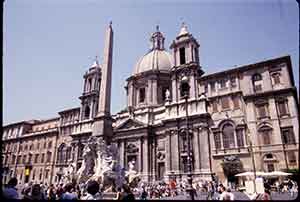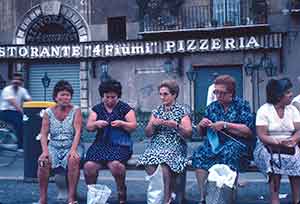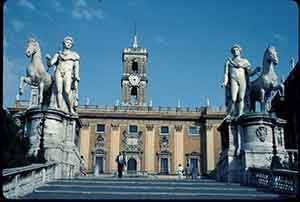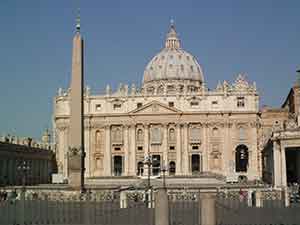Click button for detailed article about each place.
ROME
During three days we will have ample time to see the standard highlights – plus some hidden corners that most tourists never see. Wear comfortable shoes to protect your precious feet, which is crucial to discovering this city. You cannot see much of the real Rome on a standard bus tour, which actually wastes a lot of time getting stuck in traffic -- so you have got to walk to appreciate the incredible art, ancient architecture, the best food, impressive churches, quaint cobbled alleys, unlimited shopping and cozy neighborhoods.

PIAZZA NAVONA and PANTHEON
We arrive in Rome in the afternoon and transfer to our hotel for check-in and lunch. Our first walk brings us into the Piazza Navona, with its picture-postcard perfect St. Agnese Church by Borromini, and the stunning Fountain of the Four Rivers by Bernini -- artists you will encounter several more times in Rome as they were the greatest of Baroque architects and sculptors. This centrally located piazza is considered one of the most beautiful and lively outdoor spaces in the world, and you will probably return here several times, for it is interesting night and day. Originally built as a racetrack by the ancient Roman emperor Domitian, it still retains the original oval shape that gives it a unique appearance. Lined with restaurants and palaces, the piazza is enclosed by faded pastel facades all around that produce a rich feeling of antiquity.
.jpg)
From here walk two short blocks to the best-preserved ancient building in Rome -- the Pantheon, a perfect structure, still standing with its great dome intact after one thousand nine hundred years. It was the largest dome in the world until this century, and forms a spherical space that creates a balanced feeling of harmony.
Its spherical design takes the shape of a bubble on a barrel where the height of 140 feet is equal to its width, a dome atop the cylindrical base wall. The Pantheon was designed by the emperor Hadrian in A.D. 125 as a temple to all the gods, and has served a variety of historical functions over its many years. It is situated on the Piazza della Rotunda, which has several over-priced cafes and restaurants, and a beautiful fountain in the middle with an Egyptian obelisk.
You are probably ready for refreshments -- perhaps some rich Italian ice cream around the corner at Giulitti’s, the city’s best gelateria, or an espresso at Tazza D’Oro, or better yet, their famous granita, an icy coffee with whipped cream, a type of rocket fuel energy jolt that keeps you going a few more hours.
Let’s walk to another incredible church, St. Ignazio, with its illusionistic ceiling mural painted during the 17th century by the Jesuit priest, Andrea Pozzo. This vivid three-dimensional perspective will shock your eyes with its realistic depiction of the heavens opening above and painted architecture that blends magically with the building so you don’t know where one begins and the other ends. Notice the stage-setting quality of its small piazza in front, where it seems an outdoor opera could begin any moment. This is one of Rome’s few building ensembles of rococo design, with graceful curved facades unified in earth-toned colors.
TREVI and SPANISH STEPS
A few blocks away, across the busy Via del Corso, is the spectacular Trevi Fountain, made famous in the movies “Three Coins in the Fountain” and “La Dolce Vita”. It is very possibly the world’s most beautiful fountain, depicting Neptune, god of the ocean, being pulled through a triumphal arch by wild horses amidst a torrential cascade, heralded by conch blowers. Here you must toss a coin over your shoulder once to come back to Rome, and once again for another wish. Trevi was built during the 18th century in a baroque style, but it celebrates the ancient Aqueduct of the Virgin, one of a dozen important waterways that brought water into the city. Two thousand years ago Rome had more fresh water per capita than any modern city, which explains how a million people could live here at the empire’s peak – giving rise to the ancient world’s largest city.
We finish our excursion by walking a few more blocks to the Spanish Steps, but along the way look for the Church of St. Andrea delle Fratte to see another combination of great works, the angels inside by Bernini, and the brick dome by Borromini. There is also a peaceful cloister where you’ll find a moment’s refuge from the busy streets.
The Spanish Steps and adjacent Piazza di Spagna are absolutely bursting with people all the time, attracted here by a special combination of wonderful urban elements. The setting is another painting come to life, with the curvaceous broad staircase elevating your eye to the twin-towered church of Trinita di Monti, accented by an Egyptian obelisk, and equally interesting sights in all other directions. Five of the city’s best shopping streets emanate from the foot of the steps, creating a 20-block grid of retail heaven where cars are prohibited. The delightful ambience here shows why Rome has no need for modern shopping malls. This is a recurring pattern of pedestrian-only retail zones repeated in most of Europe’s major cities, each with their own unique cultural variations. It shows how much we have lost in America by destroying our towns for the sake of uniform drive-in malls.
.jpg)
You might settle in for dinner in any of a dozen fine restaurants in this neighborhood. Some of your best bets include La Rampa, Re Degli Amici, Al 34 and Mario.
After dinner you will have renewed energy to keep walking on a fascinating route back to the hotel, or you could simply take a taxi if this day has caught up with you.
A particularly good spot for some evening browsing here is the Via del Corso, one of the main retail streets of Rome where most shops now stay open all day. We continue walking through the narrow back lanes, alive with many others out for an evening stroll, and after about 45 minutes we reach our hotel where we shall enjoy a good night’s sleep.
DAY TWO:
Our schedule will take us to the four most important historic highlights of Rome: the Ancient Forum, the Colosseum, the Vatican Museum and St. Peters.
GHETTO
Start your walk from the Largo Argentina, an unusual collection of four ancient temples right in the middle of the busy city streets, also home to Rome’s largest collection of wild cats. The temple complex was only discovered during the 1930s when a construction project uncovered them. The government wisely chose to protect this site and partly rebuild the temples to give the modern visitor a glimpse below the surface into prehistory. Here you clearly can see that modern Rome is about 30 feet higher than the ancient ground surface, which makes one wonder what other treasures are still buried.

We are now walking into the “Ghetto” neighborhood, which is not a slum but the historic section where Rome’s Jews lived in the Middle Ages. It still retains a medieval feeling so typical of the many hidden nooks and crannies of the city. Narrow cobbled alleys lead from one little crooked space to another -- a palace here, a church there. The cutest item is the Fountain of the Turtles, a Renaissance fixture of four life-size naked youths standing on giant seashells in the Piazza Matei, attached to some legend about a nobleman losing his fortune in a card game but having the fountain built overnight anyway to impress his future father-in-law.
Continuing along in the Ghetto, you could walk past the Portico of Octavia, built by Rome’s greatest emperor, Augustus, as a large complex that has now been reduced to a few columns and broken fragments. Next to it is one of the three great restaurants of this neighborhood, Giggeto, the others being Vecchia Roma and Al Pompiere. It’s too early to eat now, so make a note for this evening when you are looking for something wonderful to eat. The huge building beyond the Portico that looks like the Colosseum is actually the Theater of Marcellus, also built by Augustus two thousand years ago as an enclosed theater that could hold 13,000 people. Not only is it still standing, the upper floors have been converted to luxury modern apartments for millionaires.
CAPITOLINE and FORUM

Walk up the busy Via Teatro Marcello to the Capitoline Hill, ascending the broad steps to the top for a grand view of three palaces and a classic overview of the forum. This hilltop is reputed to be the site of Rome’s first settlement, 2,750 years ago, and has been utilized ever since. Re-designed by Michelangelo to include the equestrian bronze statue of Marcus Aurelius in the center surrounded by neo-classical facades, this piazza is home to the world’s oldest museum, The Capitoline, and the adjacent Conservators Palace. They are the only museums open most evenings until 9:00 p.m., so make note of their schedule and come back later. The best view looking down at the forum is from the right side of the hill, then return to the left side for another view and the route down along a curved narrow road.
At the bottom of the hill you will be facing Trajans Forum, with its towering column and impressive covered market, two of the most important ruins from antiquity. The Roman Empire reached its maximum size at the beginning of the second century under the emperor Trajan after his conquests over Dacia, today’s Romania. This is celebrated by the spiral relief sculpture that wraps around Trajan’s Column, depicting his victories in a marble scroll that would stretch for 656 feet if it were unfurled. The huge market was built with the gold captured in the wars.
Most of this forum is gone now, but the one structure you must look at for free from the sidewalk is Trajan’s Market, perhaps the world’s first multilevel covered shopping mall. A beautiful brick buildings five stories high, it had 150 stores and offices arranged in a graceful curved brick building that still stands. Many little shops of modern Rome are quite similar to these ancestral spaces. Return across the street and enter the Ancient Forum, which no longer charges an admission fee.

Meander through the ruins of the Imperial Forum, where Romans gathered for business, gossip, politics, and just hanging out. This site is the forerunner of our modern town centers and shopping malls. Walk the smooth paving stones of the Via Sacra from one end to the other, covering a half-mile lined with marble ruins. Three triumphal arches have been standing proudly here for 2,000 years, honoring the emperors Constantine, Titus and Septemius Severus. You could rent the dramatic audiotape tour that will bring these ancient ruins back to life. Inspect the House of the Vestal Virgins, where an ancient flame was miraculously kept constantly burning. The largest building was the Basilica of Constantine and Maxentius, its brick arches and roof soaring 115 feet high, covering an area the size of a football field. Originally used as a courthouse and general gathering place, one third of it is impressively preserved today.
We will skip the Palatine Hill, home to many emperors, for it’s a strenuous hike and there is not much left to see up there anyway. Just looking at the Palatine from the Forum is impressive enough -- it was reinforced with so many old brick walls it almost looks like the entire natural hill was man-made. Exit the Forum past the remains of Hadrian’s Temple of Venus, said to have been the most beautiful of all, but today just a few stubs of columns.
COLOSSEUM
.jpg)
You are now facing the Colosseum, home of Rome’s gladiators and largest building ever constructed by those engineering masters of the ancient world. Admire the grandeur of this massive stadium, the model for all our modern sports arenas. Packed with 50,000 spectators screaming for blood nearly every day for 300 years, it was the place where commoners could be entertained and relieve the tensions of their otherwise difficult lives. Most people lived in crowded appalling conditions, so this stadium played a role in keeping the public satisfied – at least they were not down on the floor getting eaten by lions!
It still stands, despite being looted for centuries as a marble quarry for the many palaces built throughout the city. Your 12 euro admission charge includes access to the upper level, so take advantage and climb the steps, then walk all around to gain wonderful views inside and out across the forum, our next target.
VATICAN
Next we are going to the Vatican Museum by taxi. The museum is less crowded in the afternoon, so the wait to get in should be minimal, unlike mornings when you might stand on line for two hours.
We can have a convenient lunch in the Vatican cafeteria, where the prices are reasonable and the food delicious. This break will give us the energy to power through the enormous museum.
We will see the principal highlights: the Belvedere Courtyard with its half-dozen essential statues, especially the Lacoon; Gallery of the Maps for its astonishing ceiling of painted stucco sculpture and cooling views over the pope’s gardens; and Raphael’s Rooms where the great genius did his most important murals.
Of course the major single attraction of the Vatican Museum is the Sistine Chapel. Looking up you will see the world’s most important painting, summarizing the development of life on earth and mankind’s quest for salvation. Take fifteen minutes to absorb the genius of Michelangelo. Then, there is door out the back corner of the Sistine Chapel that will lead us right to St. Peters, which saves walking two miles in the wrong direction.
SAINT PETERS

St. Peters is the most spectacular room ever built! No place else can even come in a close second to this. We will spend one hour admiring the vast noble spaces with 500 statues, 45 altars, subterranean crypts, Michelangelo’s dome and Pieta, Bernini’s Baladacchino, mosaics, monuments, tombs, marble details and angels everywhere. We leave the Vatican by taxi for the short ride back t o the hotel.
This evening, after a brief rest, step out for dinner, Roman style! Trastevere is one of the best neighborhoods for restaurants, just across the Tiber River. Numerous little trattorias abound in the side streets, and we’ll be sure to stop by Piazza Santa Maria in Trastevere, facing a fine 12th century church. After dinner we stroll through this colorful neighborhood back across the Tiber River to our hotel next to the Pantheon.
DAY THREE:
We will lead a morning walking tour that will show you “the real Rome”, some of the most fascinating and historic neighborhoods in the heart of town within the curve of the Tiber River.
CENTRO STORICO, the historic center
We begin our morning walk at the Palazzo Farnese, one of the most famous renaissance palaces of the city, currently housing the French Embassy. One block away is the Campo dei Fiore, a colorful outdoor fruit and vegetable market that has been in business for three hundred years. Its food stands are very popular with the local residents, and you will even find some clothing stalls and souvenirs scattered among the local wares. It is a colorful place for candid people pictures and a good spot to pick up some refreshments, but only in the morning, since it closes at noon when all the restaurants open around the square. Come back at night as well, for it is one of the most popular spots for young people to hang out.
Next walk along the charming narrow streets of this neighborhood to experience the center of Renaissance Rome. Amazingly, this is still the heart and soul of Rome, yet few tourists ever see it. You will find streets named Giulia, Giubonari, Pellegrino, and then crossing the busy Vittorio Emmanuele, enter the Chiesa Nuova. Here you can sit and rest while admiring the elaborate decorations in the high baroque style. Next door is the convex facade of Borromini’s Oratorio, and behind it look for his Orologia Clock Tower, recently restored.
This path leads you back into the calm historic center of the city, walking along Via dei Banci Nuovi on your way to Ponte S. Angelo, the beautiful bridge across the Tiber lined with Bernini’s divine angels. These neighborhoods are saturated with charm and character. You will walk along cobbled pedestrian lanes lined with old brick buildings five stories high, containing little stores and workshops on the ground level, with apartments upstairs in a pattern followed for two thousand years.
Walking in this simple quiet neighborhood will be one of the most interesting experiences of your entire European trip. You will see artisans working in shops unchanged for centuries; fruit and flower stands for the local residents; attractive little restaurants for locals; fountain faces popping out of walls; stray cats prowling the alleys; ivy-covered brick walls 400 years old. Take your time as you wander through, passing the antique shops of Via dei Coronari on your way back to Piazza Navona.

We fly home the next day.
That completes our tour from Barcelona to Rome!
.jpg)